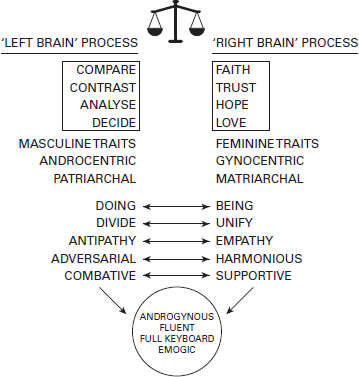Figure 7.1 LAB Brain Model

Source: LEWIS Rise Academy
We split these and assign gender traits to the processes, because this is where the research takes us. Attaining equality of masculine and feminine approaches is part of balanced leadership. It would be sub-optimal, however, if all board directors thought and behaved like men, irrespective of gender. A gender-biased organization is inherently inefficient. The ideal solution is a blend, where androcentricity combines with gynocentricity to create androgeneity. This is the combination of logic and emotion into the ‘emogic’.
It is important to state that we do not accept that male and female ability differs due to genetics or physiology, but to socialization. One of the key variables that helps to socialize behaviour is the technology we use.
What is androcentricity?
Much of the internet-driven changes have created an androcentricity or overwhelmingly masculine approach. What is the evidence for this? The extent to which the technology engenders analytic and quantitative rather than qualitative thinking.
This is vested in the Top Ten Applications of the Internet,26 which are:
- E-mail and other communications
- Research
- File downloads
- Discussion groups
- Interactive games
- Education and self-improvement
- Dating
- Electronic media
- Job-hunting
- Shopping
E-mail and other communications interrupt us. Every time this happens, we enter a left-brain process: Who is the mail from? What does it need me to do? Should I respond? The internet allows us to compare, contrast and analyse everything – ourselves, our weight, our calories, our heart rate – and it allows us to compare and contrast products and prices – again the left brain. It allows us to analyse our partners and position them against future options.
The net result is a huge uptick in data. In recent times, ‘big data’ has become a popular concept. The technology gives us more data to analyse. It not only allows us to compare ourselves with others but to compare ourselves today with yesterday and the year before that.
Who was the internet built by and for whom?
It’s probably fair to say that men invented the internet. They developed it for the US military. They invented it in their own likeness, at least as it was in the 1970s and 1980s. The data that the internet generates are used to classify and segment and then to re-target. The internet sorts, shapes and ranks. Data are analysed, broken down and then analysed again. We think of the internet as a great leveller, a democratizer, a place that opens doors to everyone. The reality, however, is that the internet is dominated by some very specific uses.
Men are the largest consumers of pornography and sexual services. More men visit porn sites on the web than visit Amazon, Netflix and Twitter combined.27 About a third of all web traffic is pornography.28 One of the world’s largest adult sites, Pornhub, an explicit-video-sharing site, gets 2.4 million visitors per hour. In 2015 alone, people around the globe watched 4,392,486,580 hours of its content.
Gender differences on social media
Men also dominate the conversation on comments boards across the internet, especially when they can post under a pseudonym, according to a study.29
Dr Fiona Martin of Sydney University took a sample of comments from 15 major websites and analysed the gender of the commenters. She categorized people as either male, female or ambiguous (Figure 7.2). On international sites, men accounted for as much as 79 per cent of the commenters, while the highest proportion of women to post on the same sites was only 20 per cent. While women were slightly more likely to comment on local news sites, reaching 35 per cent on one publication, men still appeared to dominate the conversations.